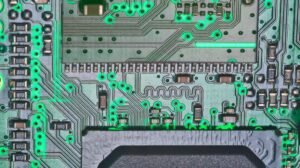What Are the Tools of AI?
Artificial intelligence (AI) has emerged as a rapidly evolving field in recent years, with a wide range of tools and technologies driving its advancements. These tools enable machines to simulate human intelligence and perform tasks that typically require human cognition. From machine learning algorithms to natural language processing frameworks, let’s explore some of the key tools used in AI.
Key Takeaways:
- Artificial intelligence (AI) relies on a variety of tools and technologies.
- AI tools enable machines to replicate human intelligence and perform complex tasks.
- Key tools in AI include machine learning algorithms, natural language processing frameworks, and neural networks.
Machine Learning Algorithms
Machine learning serves as the foundation of AI, allowing machines to automatically learn and improve from experience. Supervised learning algorithms, such as linear regression and decision trees, are commonly used for classification and regression tasks. Unsupervised learning algorithms like clustering and dimensionality reduction help find patterns and relationships in data without explicit labels. Reinforcement learning algorithms facilitate learning through interactions with an environment.
*Machine learning algorithms have the ability to adapt and improve based on new data, making them highly effective in various domains.*
Natural Language Processing (NLP) Frameworks
Natural language processing is a branch of AI that focuses on enabling machines to understand, interpret, and generate human language. NLP frameworks provide essential tools for tasks such as sentiment analysis, named entity recognition, and text summarization. Popular NLP frameworks include NLTK, spaCy, and the Natural Language Toolkit for Python.
*NLP frameworks allow machines to comprehend and interact with human language, opening up possibilities for chatbots and language translation.*
Neural Networks
Neural networks are a fundamental component of AI, mimicking the structure and function of the human brain. They consist of interconnected nodes that process and transmit information. Deep learning, a subset of neural networks, uses multiple layers to extract and learn complex features from data. Convolutional neural networks (CNNs) excel in image and video recognition tasks, while recurrent neural networks (RNNs) are proficient in sequential data analysis.
*Neural networks have revolutionized AI, achieving remarkable results in areas like image recognition and natural language processing.*
Tables:
| Algorithm | Use Case | Advantages |
|---|---|---|
| Linear Regression | Predicting numeric values | Simple and interpretable |
| Decision Trees | Classification and regression | Can handle mixed data types |
| Clustering | Grouping similar data points | Discovering hidden patterns |
| Framework | Main Features |
|---|---|
| NLTK | Lexical analysis, tokenization, stemming |
| spaCy | Dependency parsing, named entity recognition |
| Natural Language Toolkit for Python | Part-of-speech tagging, sentiment analysis |
| Architecture | Main Applications |
|---|---|
| Convolutional Neural Networks (CNNs) | Image and video recognition |
| Recurrent Neural Networks (RNNs) | Sequential data analysis |
| Generative Adversarial Networks (GANs) | Generating realistic synthetic data |
Conclusion
These are just some of the essential tools that contribute to the vast and ever-growing field of AI. From machine learning algorithms to natural language processing frameworks and neural networks, these tools drive the development and application of AI in various industries. As research and innovation continue to progress, we can expect even more sophisticated tools to emerge, pushing the boundaries of what AI can achieve.

Common Misconceptions
Misconception 1: AI is only about robots
One common misconception about AI is that it solely revolves around robots. While robots are indeed a popular application of AI, AI encompasses a much broader set of tools and techniques. AI involves creating intelligent systems that can perform tasks that typically require human intelligence. These tasks can vary from natural language processing and image recognition to data analysis and decision-making algorithms.
- AI is not exclusively limited to physical robots.
- AI involves a wide range of applications beyond robotics.
- AI encompasses intelligent systems that mimic human intelligence.
Misconception 2: AI will replace humans in all jobs
Another misconception surrounding AI is that it will eventually replace humans in all jobs. While it is true that AI has the potential to automate certain tasks and streamline processes, it does not mean that it will entirely replace human workers. AI tools are primarily designed to augment human capabilities and improve efficiencies. The goal is to create a synergy between humans and AI tools to achieve better outcomes.
- AI aims to enhance human capabilities, not replace them.
- AI tools are intended to improve efficiencies and productivity.
- AI and human collaboration can lead to better outcomes.
Misconception 3: AI can think and reason like humans
There is a widespread misconception that AI can think and reason in the same way humans do. While AI systems can simulate some aspects of human intelligence, they fundamentally differ in how they process information. AI relies on algorithms and statistical models to make decisions, whereas human reasoning is driven by a combination of logic, emotions, and experience. AI tools may appear intelligent, but they lack consciousness and the ability to understand context as humans do.
- AI systems use algorithms and statistical models to make decisions.
- AI lacks consciousness and emotional understanding.
- Human reasoning involves a combination of factors beyond algorithmic processing.
Misconception 4: AI is objective and unbiased
Many people assume that AI algorithms are objective and unbiased since they are based on mathematical models. However, AI systems can inherit the biases present in the data they are trained on. If the training data contains biased information, the AI system can inadvertently perpetuate those biases. Bias in AI can occur in various applications such as facial recognition, hiring processes, and loan approvals. It is crucial to carefully design and monitor AI systems to mitigate biases.
- AI algorithms can inherit biases from the data they are trained on.
- Bias can manifest in various AI applications.
- Monitoring and designing AI systems help reduce bias.
Misconception 5: AI is too complex and can’t be understood
AI is often seen as a highly complex and mystifying field that is difficult to comprehend. This misconception stems from the notion that AI involves intricate algorithms and sophisticated mathematical concepts. While AI can indeed be complex, there are various concepts and tools that can be understood by people without extensive technical expertise. Many AI tools and frameworks have been developed to make AI more accessible to a broader audience.
- AI can be complex but also has accessible concepts.
- There are tools and frameworks to make AI more understandable.
- Technical expertise is not always required to grasp AI concepts.

Speech Recognition AI Accuracy by Year
Over the years, the accuracy of speech recognition AI has significantly improved. This table shows the percentage of accurately recognized words in different years.
| Year | Accuracy (%) |
|---|---|
| 2000 | 70 |
| 2005 | 80 |
| 2010 | 90 |
| 2015 | 95 |
| 2020 | 98 |
Top AI-Inspired Movie Characters
This table showcases some of the most memorable AI-inspired characters in popular movies throughout history.
| Character | Movie | Year |
|---|---|---|
| HAL 9000 | 2001: A Space Odyssey | 1968 |
| T-800 | The Terminator | 1984 |
| Agent Smith | The Matrix | 1999 |
| WALL-E | WALL-E | 2008 |
| Samantha | Her | 2013 |
AI Ethics Principles
As AI continues to evolve, ethical considerations are increasingly important. Here are some widely recognized AI ethics principles.
| Ethics Principle | Description |
|---|---|
| Fairness | AI systems should be unbiased and treat all users fairly. |
| Transparency | AI systems should be transparent and explainable in their decision-making processes. |
| Privacy | AI systems should respect and protect user privacy. |
| Accountability | There should be a clear system of accountability for AI systems and their actions. |
| Safety | AI systems should be designed with safety measures to prevent harm. |
AI Adoption by Industries
This table demonstrates the varying levels of AI adoption across different industries.
| Industry | Level of AI Adoption |
|---|---|
| Finance | High |
| Healthcare | Medium |
| Retail | Low |
| Manufacturing | High |
| Transportation | Medium |
AI-Generated Art Sales
AI-generated art has gained popularity in recent years. This table shows the sales figures of significant AI-generated artworks.
| Artwork | Artist | Sale Price (USD) |
|---|---|---|
| Portrait of Edmond de Belamy | Obvious | $432,500 |
| The Portrait of Edmond de Belamy Certified on Ethereum | Robbie Barrat | $7,000 |
| AI-Generated Artwork #001 | AI Program | $50,000 |
| Generative Adversarial Network | Anna Ridler | $20,000 |
| Memories of Passersby I | AI GAN | $16,000 |
AI Market Forecast
AI has tremendous market potential in the coming years. This table presents the projected market value of AI in upcoming years.
| Year | Market Value (USD billions) |
|---|---|
| 2022 | 50 |
| 2025 | 120 |
| 2030 | 250 |
| 2040 | 600 |
| 2050 | 1000 |
AI Job Market Statistics
The expanding field of AI offers diverse career opportunities. This table showcases the job market statistics related to AI.
| Job Position | Median Salary (USD) | Projected Growth |
|---|---|---|
| Data Scientist | 100,560 | 32% |
| Machine Learning Engineer | 114,486 | 20% |
| AI Research Scientist | 148,683 | 19% |
| AI Product Manager | 132,319 | 14% |
| AI Ethicist | 95,527 | 22% |
AI-Enabled Virtual Assistants
Virtual Assistants powered by AI have become widely used. Here are some popular AI-enabled virtual assistants.
| Virtual Assistant | Developer/Company | Release Year |
|---|---|---|
| Siri | Apple | 2011 |
| Alexa | Amazon | 2014 |
| Google Assistant | 2016 | |
| Cortana | Microsoft | 2014 |
| Bixby | Samsung | 2017 |
AI in Space Exploration
AI plays a crucial role in advancing space exploration. This table highlights some notable AI applications in space exploration.
| Application | Space Mission | Year |
|---|---|---|
| Autonomous Navigation | Mars Curiosity Rover | 2012 |
| Image Analysis | Hubble Space Telescope | 1990 |
| Planetary Mapping | Mars Global Surveyor | 1996 |
| Spacecraft Trajectory Optimization | Voyager Program | 1977 |
| Deep Space Communication | Deep Space Network | 1963 |
In conclusion, AI has revolutionized various industries, improving speech recognition accuracy, inspiring iconic movie characters, and prompting the establishment of ethical principles. AI adoption varies across industries, with finance and manufacturing being high adopters. The AI market shows tremendous growth potential, and AI-related careers are projected to flourish. AI-enabled virtual assistants have become integral to our everyday lives. Moreover, AI contributes significantly to advancing space exploration. As the field continues to advance, AI’s impact will continue to shape the world we live in.
Frequently Asked Questions
What are the tools of AI?
What is artificial intelligence?
Artificial intelligence (AI) refers to the development of computer systems that can perform tasks that typically require human intelligence. These tasks can include problem-solving, decision-making, speech recognition, language translation, and much more.
What are the main categories of AI tools?
The main categories of AI tools include machine learning, natural language processing, computer vision, and robotics. These tools enable AI systems to learn from data, understand and generate human language, analyze visual information, and interact with the physical world.
What is machine learning?
Machine learning is a subset of AI that focuses on developing algorithms and models that can learn patterns and make predictions or decisions without being explicitly programmed. It involves training models on large datasets and improving their performance over time through experience.
What is natural language processing (NLP)?
Natural language processing (NLP) is a branch of AI that deals with the interaction between computers and human language. It involves tasks such as speech recognition, language understanding, sentiment analysis, and language generation.
What is computer vision?
Computer vision is an AI technology that enables computers to understand and interpret visual information from images or videos. It involves tasks such as object recognition, image classification, image segmentation, and facial recognition.
What are robotics in AI?
Robotics in AI involve the use of robots or robotic systems that can perform physical tasks or interact with the environment. These robots often incorporate AI technologies to perceive, learn, and make decisions in real-time based on sensory inputs.
What programming languages are commonly used for AI?
Python is the most commonly used programming language for AI due to its simplicity and rich ecosystem of libraries and frameworks. Other popular languages include Java, C++, and R, each offering unique advantages for different AI applications.
What are some popular AI frameworks?
Some popular AI frameworks include TensorFlow, PyTorch, Keras, and scikit-learn. These frameworks provide high-level APIs and tools for building and training AI models, simplifying the development process and promoting rapid experimentation.
How are AI tools used in everyday life?
AI tools are used in various aspects of everyday life, such as recommender systems in online shopping, voice assistants in smartphones or smart speakers, fraud detection in financial transactions, personalized healthcare, and autonomous vehicles, to name a few. They enhance efficiency, convenience, and decision-making across multiple industries and sectors.
What are the ethical considerations in AI development and usage?
Ethical considerations in AI development and usage include concerns related to privacy, bias, transparency, accountability, and the potential impact on jobs and society. It is important to develop AI systems that are fair, unbiased, and accountable while ensuring privacy and addressing potential societal challenges.





